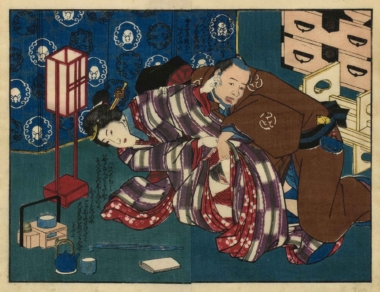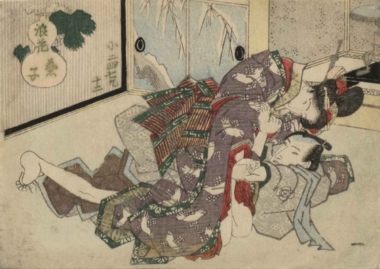

SHUNGA
Spring pictures
Shunga is the traditional Japanese term for erotic paintings and prints, also known as pillow paintings (makura‑e) or secret paintings (higa). Shunga illustrate urban pleasures and bourgeois everyday phenomena around the theater and entertainment districts of Edo, today’s Tokyo. The formal treatment of naked bodies and the sometimes multilayered arrangements of kimono folds clearly set Shunga apart from naturalistic depictions of lovemaking. Characteristic are the anatomical detail, partly extreme body positions and oversized genitals. Often Shunga also show humorous scenes. Almost all famous ukiyo‑e artists also designed erotic woodblock prints. Utamaro (ca. 1753/54–1806) transformed Harunobu’s (ca. 1725–1770) originally dreamy erotic scenes into more explicit depictions. Utamaro gave more naturalness to the genre and also showed semi-erotic domestic scenes such as beauty(bijin-ga) grooming.
During the Meiji era (1868–1912), the quality of shunga varied. The focus was no longer on beauty, but rather on erotic motifs. The spring paintings, which were banned by the government, were sold unsigned under the table.
SHUNGA
Spring pictures
Shunga is the traditional Japanese term for erotic paintings and prints, also known as pillow paintings (makura‑e) or secret paintings (higa). Shunga illustrate urban pleasures and bourgeois everyday phenomena around the theater and entertainment districts of Edo, today’s Tokyo. The formal treatment of naked bodies and the sometimes multilayered arrangements of kimono folds clearly set Shunga apart from naturalistic depictions of lovemaking. Characteristic are the anatomical detail, partly extreme body positions and oversized genitals. Often Shunga also show humorous scenes. Almost all famous ukiyo‑e artists also designed erotic woodblock prints. Utamaro (ca. 1753/54–1806) transformed Harunobu’s (ca. 1725–1770) originally dreamy erotic scenes into more explicit depictions. Utamaro gave more naturalness to the genre and also showed semi-erotic domestic scenes such as beauty(bijin-ga) grooming.
During the Meiji era (1868–1912), the quality of shunga varied. The focus was no longer on beauty, but rather on erotic motifs. The spring paintings, which were banned by the government, were sold unsigned under the table.




Recent Comments